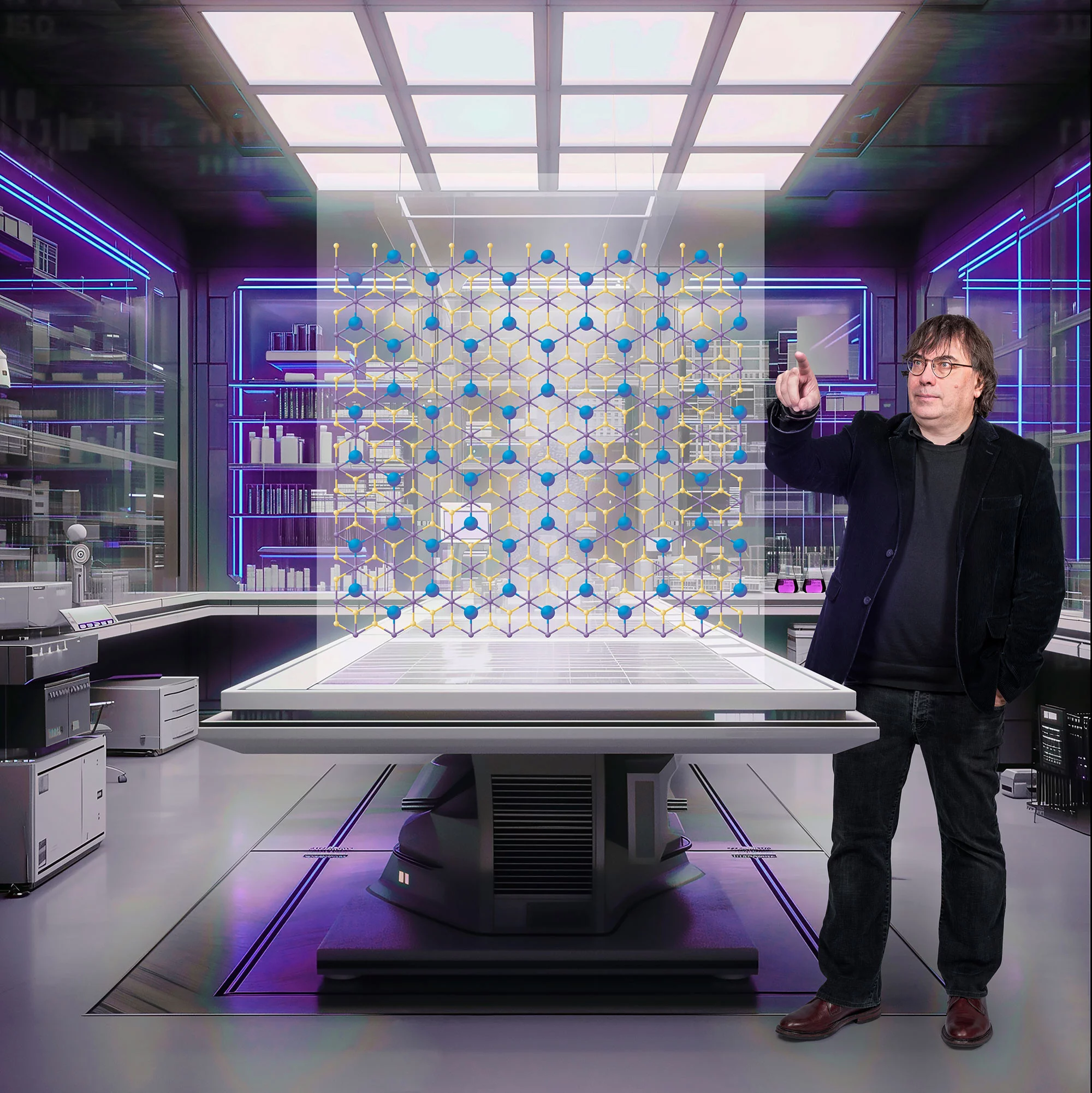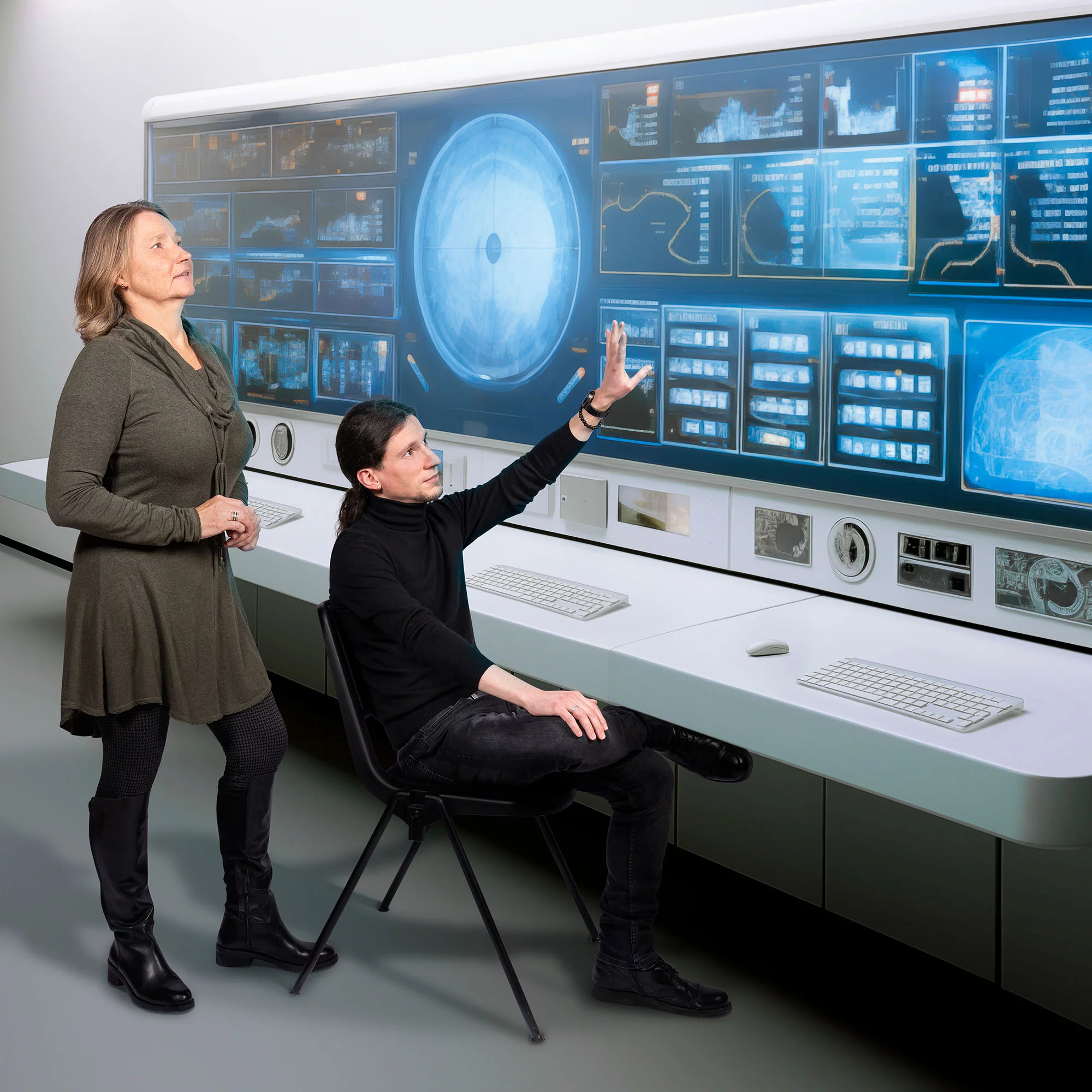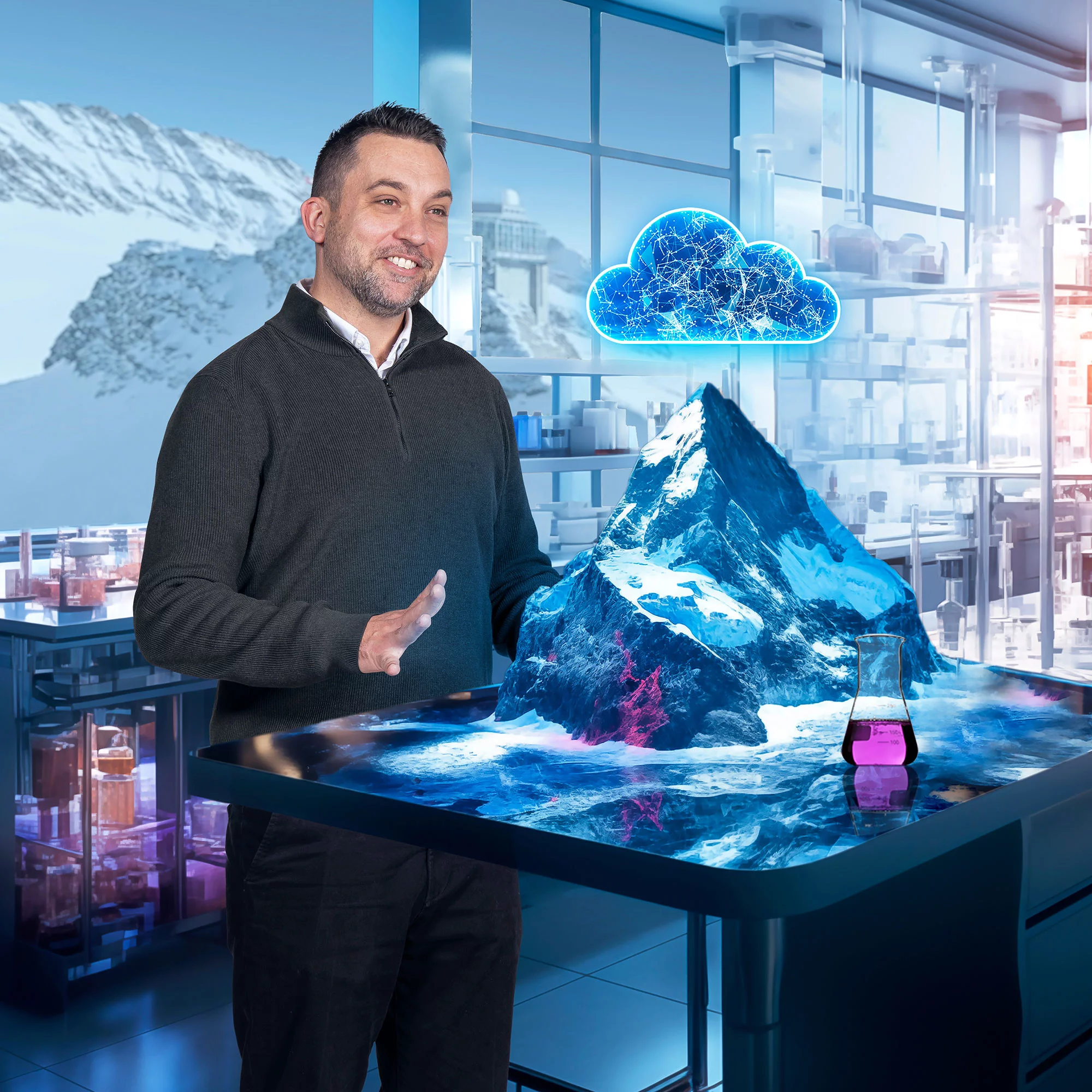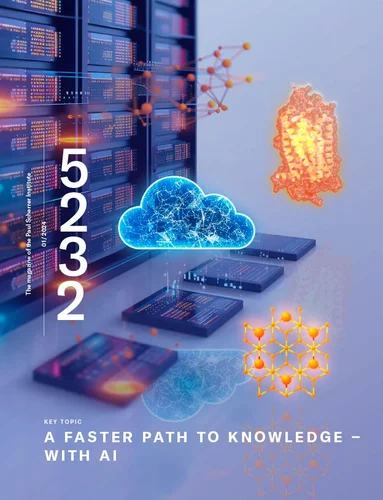Today, machine learning and artificial intelligence are part of the toolkit for most researchers at PSI. In many cases these methods are fundamentally transforming the way we do science.
Could the future of the world and all the atoms in the universe be calculated? An intelligent entity with knowledge of all the forces would be able to do it, according to French mathematician Pierre-Simon Laplace (1749–1827). “To it, nothing would be uncertain: it could make sense of both the future and the past.” But now we know that Laplace was wrong: the universe can never be completely calculated and predicted. This has been resoundingly proven by the theory of relativity and quantum physics, among other things.
Really? Maybe Laplace’s demon, as it’s called, knows some kind of shortcut that allows it to infer an effect from a cause without needing to perform all the physical calculations in between. This shortcut actually exists and is referred to as machine learning and deep learning with neural networks. Both are forms of artificial intelligence.
Today machine learning is an integral part of physics, chemistry, biology and many other scientific disciplines. Most of the time this involves recognising connections without investing the computational effort that would be necessary to solve all of the physical equations in the Laplacian sense. At PSI, machine learning, neural networks and AI-based methods are applied in many projects. Four examples show how these methods are changing – one could say revolutionising – research at PSI.
Materials research: No more trial and error
What happens in a lithium-ion battery? When the battery is charged, lithium ions migrate into the cathode; when the battery is discharged, the ions migrate out of the cathode again. In the process, the number of electrons in the cathode material is constantly changing; that much is known. “But up to now, computer calculations have had difficulty accurately capturing exactly what is happening, especially what forces are at work,” says Nicola Marzari, head of PSI’s Laboratory for Materials Simulations and professor at EPFL in Lausanne. But this is crucial, for building better batteries for example for electric vehicles. To calculate these processes, physicists like Marzari use the Schrödinger equation, the most basic – yet also, unfortunately, very complex – equation in quantum physics. Calculating the dynamics of just a few lithium ions during charging and discharging would require the computational power of all the computers in the world. Fortunately, chemist Walter Kohn managed to simplify the numerical application of the Schrödinger equation in 1965.
Yet even in this form, it exceeds today’s computational capacities. Here it would be useful if there were a shortcut that bypasses the complex calculation and infers the result directly from the starting conditions – without having to consider the behaviour of each individual lithium ion. This sounds like a job for machine learning – and that’s exactly what researchers have been using successfully for several years. “Our model is a black box: it delivers the dynamics of the lithium ions directly without the complexity of thorough quantum calculations,” Marzari says.
But first the model must be trained. To do that, Marzari uses Walter Kohn’s theory to calculate many different atomic configurations, varying temperature, displacements and the diffusion of all the atoms of a material. In this way he generates physical “snapshots” that he feeds into the model. Once trained, the model is able to generate new snapshots without the need for complicated formulas and massive computing power. The PSI team is using this method to develop solid electrolytes for batteries that will not catch fire as easily as current ones with flammable liquid electrolytes. For large-scale energy storage, it would also be interesting to see if lithium could be replaced with other materials that are more common in the earth’s crust, such as sodium, magnesium and potassium.
Better materials for batteries are just one example showing how quantum simulation and machine learning are revolutionising materials research. At PSI’s Laboratory for Materials Simulations, which is part of the Scientific Computing, Theory and Data Research Division founded in 2021, scientists develop and refine computational methods for predicting and characterising the properties of materials. The laboratory collaborates closely on this with EPFL and MARVEL, which likewise is headed by Marzari. MARVEL stands for Materials Revolution: Computational Design and Discovery of Novel Materials. It is one of the national research priorities funded by the Swiss National Science Foundation over the period 2014 to 2026. “We want to understand how materials behave and what properties they have, to find new and better materials,” the scientist explains. “We can do this without experimental input. We actually work solely on the basis of fundamental quantum simulation. But then we go to our colleagues at PSI who carry out the experiments, and we work together on the synthesis and testing of these materials.”
One example in which the trial-and-error principle still worked is graphene, a carbon layer just atoms thick, with a large number of carbon atoms arranged in a honeycomb pattern. It is this two-dimensional platelet form that gives graphene its special properties. For decades, researchers cleaned graphite, which they used as a test material in the laboratory, by sticking an adhesive strip on it and peeling it off. In 2004, when two physicists first examined the residue on the tape, they discovered the extremely thin carbon layers of graphene. Graphene has fascinating properties, which earned its discoverers the Nobel Prize in 2010.
With MARVEL, graphene might have been found earlier. PSI and EPFL researchers have used their computers to investigate the properties of inorganic crystalline materials such as silicon, gallium arsenide and perovskites. From 80,000 known inorganic compounds, they used quantum mechanical algorithms, simulations and machine learning to identify more than 2,000 materials that can be peeled off in two-dimensional layers. It should be possible to produce these from a three-dimensional starting material, just as easily as graphene is made from graphite.
A first success story from this work was jacutingaite. This mineral, discovered in Brazil in 2008, consists of platinum, mercury and selenium. It has nearly the same structure as graphene but is much heavier. Marzari’s team used its simulation methods to predict the unique electrical and magnetic properties of jacutingaite. It is the first and so far the only known material that realises the physics of a quantum spin Hall insulator, conceived in 2005 by two theoretical physicists at the University of Pennsylvania, Charles Kane and Gene Mele. Inspired by this discovery, experimenters at the University of Geneva managed to produce jacutingaite artificially and examine it using synchrotron radiation. The result: the predictions were experimentally confirmed, precisely.
Nuclear power plants: safely mastering accidents
There’s something you do not want to experience in any nuclear power plant: the electric power goes out and the coolant pump stops. The nuclear reactor reaches a critical temperature. Now, quickly introduce cooling water to lower the temperature. But not too much, because that had fatal consequences in the 2011 Fukushima disaster in Japan. The scenarios used to train staff regularly to safely master possible accidents in nuclear power plants tend to run more or less the same way. But the simulations neither run fast enough nor represent the physical and chemical processes in the reactor with sufficient accuracy. Besides that, they only cover the kinds of minor accidents that occur frequently.
It’s a different matter in the images viewed on a computer screen by Terttaliisa Lind, an engineer in the Laboratory for Reactor Physics and Thermal Hydraulics at PSI. “That’s not a video,” she says. “It’s a simulation with real physics that is being calculated in every moment.” If a test participant intervenes in the process, for example by opening a valve, the simulation adapts immediately. But how is that possible? The thermodynamic and chemical processes in a nuclear reactor are so complex that even the most powerful computer can’t calculate them in real time. The computer would need ten minutes to calculate what happens in reality in one minute. This means that accidents – and serious ones in particular – cannot be simulated realistically. On the other hand, some processes that occur during an incident are very slow and can take hours. The test participants would spend most of their time twiddling their thumbs.
What the power plant operators need is simulations that run in real time but can also be accelerated without sacrificing accuracy. This is precisely what Lind is working on in a project for Euratom, an organisation for the coordination and monitoring of civilian use of nuclear energy and nuclear research in Europe. Her team is one of 14 partners from ten European countries. The project started in November 2022 and runs for four years. The goal of the project is to develop a simulator for unusual and severe accidents that will represent the processes realistically according to the laws of physics. “There is currently nothing like this,” says Christophe D’Alessandro, an energy engineer and expert for ASTEC at PSI.
ASTEC is a system code, developed in France, for the simulation of serious accidents in nuclear power plants. It calculates thermohydraulic parameters such as pressure and temperatures in the reactor vessel, coolant circulation and containment, but it is very slow. In the Euratom project, D’Alessandro is developing the simulator and using a trick to do it: the model skips the multitude of physical formulas for which the computer needs so much time, and draws conclusions directly from the beginning to the end of a time step, for example when a test participant opens a valve. How does it work? Through machine learning. The model is fed with many ASTEC simulations, and at some point it is able to link causes and effects and predict the result just as correctly for new situations as if it had calculated all the formulas.
We create simulations with real physics, which is calculated at every moment.
Cancer research: tracking down tumours
If detected early, cancer is often curable. An important step in this direction was achieved by G. V. Shivashankar, head of the Laboratory for Nanoscale Biology at PSI and Professor of Mechano-Genomics at ETH Zurich. His team was able to confirm that changes in the organisation of the cell nucleus of some blood cells provide reliable evidence of a tumour in the body. Using machine learning, the researchers can identify healthy and sick people with an accuracy of around 85 percent. They were also able to correctly distinguish between different types of tumours. They were able to correctly distinguish between melanoma, glioma, and ear, nose and throat tumours. “This is the first time, worldwide, that anyone has achieved this with an AI-based biomarker for chromatin imaging,” says Shivashankar happily.
The tumours give themselves away through the blood cells’ chromatin – essentially a compact package of DNA resembling a ball of yarn. Using fluorescence microscopy, the researchers recorded properties such as the external texture, packing density and contrast of chromatin in the lymphocytes or monocytes – a total of around 200 features – using semi-supervised learning methods. They fed microscope images of samples from healthy and sick trial participants into a machine learning model. Once it was trained, the model could identify differences between healthy and diseased cells that would not be visible to human observers. In patients who had undergone treatment at the PSI Center for Proton Therapy CPT, the researchers also showed that the structure of the chromatin came closer to the normal pattern over the course of the treatment. This holds promise for potential approaches to the evaluation of therapeutic results.
Atmospheric chemistry: thousand-fold boost in calculation speed
You don’t see them, but they’re everywhere: aerosols, tiny particles in the air from dust, salt, pollen, exhaust fumes, tyre wear and many other sources. While rural residents inhale only a few hundred particles with each cubic centimetre of air, it can be tens of thousands in built-up areas – with corresponding health risks. To understand the formation and effects of aerosols, researchers in atmospheric chemistry measure the amounts and types of aerosols around the world using light-scattering experiments aboard satellites and aircraft, as well as ground-based measuring stations.
There’s a problem: depending on the properties of the aerosols, the measurement data change. But how can you draw conclusions about the properties of the aerosols from the measurement data? Robin Modini and the Aerosol Physics and Optics team in PSI’s Laboratory for Atmospheric Chemistry have gained groundbreaking insights in recent years – by training artificial neural networks in the computer, which are often used for pattern recognition. The researchers first use physical equations to simulate light-scattering patterns generated by the aerosols, and then train the neural network with these virtual patterns. The output of the neural network is the properties of the aerosols for specific measurement data. And then something like a magic trick comes into play: the polarity of the neural network can be reversed and then used to determine light-scattering patterns for specific aerosol properties.
Control measurements in the laboratory show how amazingly well this works. Samples of the air are fed into a polar nephelometer, which measures laser light scattered by the aerosols. These measurements fit the theory and the predictions of the neural network very well. With that, the researchers have a powerful instrument in hand that enables them to better understand scattering measurements from satellites and aircraft. But that’s not all: because the physical equations are redundant after the neural network has been trained, the method is extremely fast. “With machine learning, we can calculate the properties of aerosols a thousand times faster than before,” Robin Modini says. The researchers want to combine these algorithmic developments with their long-term aerosol monitoring, which has been carried out continuously on the Jungfraujoch since 1995.





